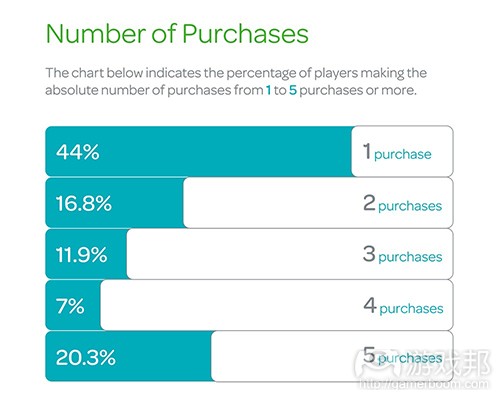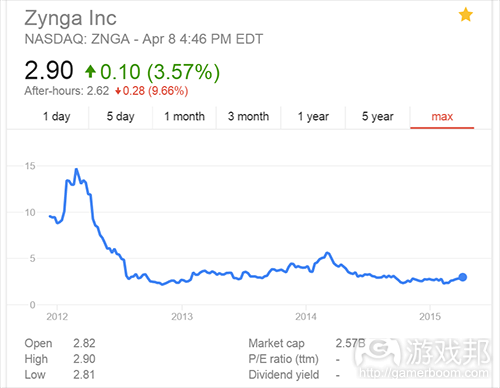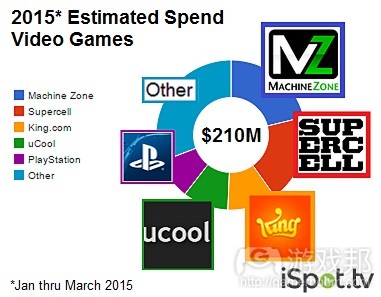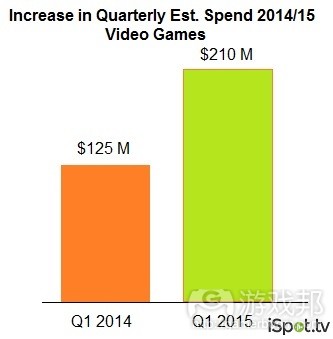每日观察:关注手机游戏玩家的月均消费水平(4.10)
1)移动营销机构Swrve最新报告发现,手机游戏高达60%的收益来自仅占比0.23%的玩家(Swrve调查了来自40多款游戏的2000多万名玩家在2015年1月为期30天的游戏行为)。
Swrve数据还显示,这些付费玩家在游戏上的月均投入为29.17美元,高于去年的22美元,增幅将近33%。其他发现还包括:
*在付费玩家中,44%在游戏中有一次消费行为,有20%的消费行为不少于5次。
*典型的付费玩家每月消费行为平均为3.5次,平均每次消费额为8.27美元。
*这些免费游戏中的“中级”虚拟道具售价介于10至20美元之间,在道具销售中占比21.9%,在游戏收益中占比38.6%(去年此项数据为22%)。
*玩家执行首次消费的平均时间仅为15小时,低于2014年时的24小时。
今年1月份在游戏中消费的玩家比例已从2014年同期的1.5%增长至2.3%。
Swrve报告认为,这一发现再次强调了游戏吸引目标玩家,尽早识别玩家,以及优化游戏体验从而最大化投入回报的重要性。
2)据venturebeat报道,Zynga日前确认了Zynga Studios主管Alwx Garden于3月份离职的消息。除此之外,Zynga还宣布领导团队新增了两名数据专家Amy Gershkoff(首席数据官)和Moises Goldszmidt(首席数据科学家)的消息。
Garden曾是Relic Entertainment创始人,其代表作包括战略游戏《Company of Heroes》和《Homeworld》,在加入Zynga之前曾与Mattrick共事,担任微软Xbox Live等相关项目总经理。
3)据venturebeat报道,Zynga将在未来两年向已经离职的前首席执行官Don Mattrick支付400万美元作为其解雇补偿金,除此之外,该公司还将向其支付约100万美元作为2015年度奖金,Mattrick还将获得价值约1000万美元的股票。Mattrick总计将由此获得1500万美元左右的补偿。
尽管Mark Pincus重新掌权,但股市反应却并不乐观,Mark Pincus的回归并没有挽回Zynga股票的颓势,该公司在4月8日收盘时股价为2.9美元,远低于Mattrick在位时股价曾达到5.58美元的水平(2012年3月,Zynga鼎盛时期股价曾高达14.69美元)。
需要指出的是,尽管Mattrick时期的Zynga股票有所反弹,但后来也一直在2美元左右徘徊。观察者认为Mattrick采取的一系列政策并未让Zynga重获新生,但Pincus重新掌舵也未必妙手回春。
4)iSpot.tv数据显示,2015年第一季度电子游戏行业前五大电视广告客户中,有4家是手机游戏公司,它们在今年的电视广告投入超过了1.3亿美元。排名前三的King、Machine Zone和Supercell在电子游戏行业的电视广告投入中占比总计达30%,超过了资深主机制造商PlayStation、任天堂和Xbox(分别名列第4、第5和第8),以及主机游戏制造商2K(第7名)、EA(第11名)和育碧(第21名)。
去年名列前茅的是主机制造商索尼和微软,两者在该类广告投入中占比36%,但今年这两者仅占比10%。尽管第一季度通常是主机游戏开发商的淡季,第四季度才是该类游戏大作的旺季,出现这一结果并不令人意外,但手机游戏公司在电视广告上的投入增长的确不容小觑。Machine Zone去年第一季度在电视广告上的投入仅占比6.7%,今年同期这一比例已增至21%;Supercell同期投入也从10%增长至22%。
5)据gamesbeat报道,Rovio日前宣布《Angry Birds Go》面世18个月下载量超过1.3亿次,并新增一个本地多人模式,支持两名玩家在同一个WiFi环境下同时同地手持不同设备在同款游戏中对抗,该游戏今后还将增加组群游戏功能。
另报道,本周该公司在愤怒小鸟虚假授权商品的诉讼中获得了自动贩售机进口及运营商Toy Amaon公司的430万美元赔偿。在2012年,愤怒的小鸟授权商品在Rovio公司2亿美元的年度收益中曾一度占比高达40%,在2014年则降至4400万美元(Rovio在2014年总收益为1.69亿美元)。
在2016愤怒的小鸟动画片即将上映之际,Rovio打击侵权商品就是提升其官方授权商品销量的一个必要举措。(本文由游戏邦编译,转载请注明来源,或咨询微信zhengjintiao)
1)Swrve says 0.23% of players accounted for 60% of revenues in a month in mobile games..
Top marketing execs: Join us June 1-2 in Boston for GrowthBeat Summit. Sign up today as space is limited and we’re limiting attendance to CMOs and top marketing execs. Request your personal invitation here.
Mobile gamers are either cheapskates or they’ve learned that they don’t really have to purchase anything in a free-to-play game. Those are logical conclusions from a new report from mobile marketing automation firm Swrve.
Swrve found that only 0.23 percent of all players generate 60 percent of all in-game revenues. That’s a tiny segment, and it’s why game companies should treat their best payers, known in the industry as whales, as high rollers.
Swrve’s report comes from data collected on 20 million players of free-to-play mobile games.
The headline seems bleak, but Swrve’s data also shows that the average monthly spend was $29.17, up from $22 in the same month last year, an increase of nearly 33 percent.
Freemium is game publishers’ top monetization option — here are the others
Mobile Games Monetization: What successful game developers do differently
These findings continue to demonstrate the importance of attracting targeted players to the game, identifying them early, and ensuring the best possible in-game experience to maximize return on investment, Swrve said.
The report also indicates the slew of mobile game business acquisitions may be waning as companies learn to manage the player lifecycle: the percentage of players who made real in-game purchases in January rose to 2.3 percent, compared to 1.5 percent in 2014.
Swrve details the percentage of players who make one or more purchases.
Here are more of the key report findings:
● Of paying customers, 44 percent made one purchase, while 20 percent made five or more
● The typical paying player makes 3.5 purchases per month, at an average purchase price of $8.27
● ‘Mid-tier’ virtual items priced at $10 to $20 drive the free-to-play business, contributing 21.9 percent of purchases and 38.6 percent of revenue. The latter figure is up from 22 percent a year ago.
● The average time to first purchase is only 15 hours, down from just under 24 hours in 2014, which makes it clear that successful titles incentivize early spend.
“The numbers are clear: the mobile games space is changing and growing,” said Christopher Dean, Swrve CEO, in a statement. “Although still reliant on a relatively small but growing number of players, there is a clear trend towards a broader payer base and a more sophisticated approach to driving revenues. We’re leaving the ‘acquisition phase’ of mobile, as developers realize that success is determined by what happens after the install.”
Swrve said the report was restricted to free-to-play games and examined 30 days of behavior for all players playing a game in January 2015. Data was collected from over 40 titles, and reflects the behavior of more than 20 million players. Swrve processes more than 6 billion events a day across a billion devices.(source:venturebeat)
2)Zynga’s head of game studios quietly left before CEO change from Mattrick to Pincus
Alex Garden, former head of Zynga Studios.
Gaming execs: Join 180 select leaders from King, Glu, Rovio, Unity, Facebook, and more to plan your path to global domination in 2015. GamesBeat Summit is invite-only — apply here. Ticket prices increase on April 10th!
Zynga confirmed today that Alex Garden, the head of Zynga Studios, departed from the company in March.
The social and mobile gaming company didn’t announce the departure at the time. But it did publicly announce Garden’s arrival when he joined about a year ago, just as then-CEO Don Mattrick assumed full control of Zynga’s day-to-day operations and founder Mark Pincus stepped back. We just heard about Garden’s departure after Mattrick resigned yesterday and Pincus moved in again as CEO. All these moves take place in an environment in which Zynga continues to find its footing in mobile gaming, a market that could hit $30 billion this year.
Zynga also added two data experts to its leadership team. It’s a move that shows the publisher wants to better understand how its players interact with its games — and better retain them.
A spokesperson for Zynga confirmed the departure and said it was a “mutual decision.” Garden was a high-profile hire, replacing Steven Chiang, who had the job of running the studios before that. The change happened before Pincus became CEO again.
Garden was the founder of Relic Entertainment, maker of landmark strategy games such as Company of Heroes and Homeworld. Just before joining Zynga, he worked with Mattrick as Microsoft’s general manager of Xbox Live, Xbox Music, Video, and Reading. At Microsoft, Garden worked with content partners like HBO, Netflix, and ESPN. He also worked at online publisher Nexon. And at Zynga, he helped usher games out the door such as the new Zynga Poker. But this update didn’t go over well, as many fans preferred the older game. That caused Zynga to bring back Zynga Poker Classic as an alternative game.
At the time that Garden joined the social game publisher, Mattrick said, “Alex Garden is an exciting hire for us as we focus on growing and sustaining our franchises, creating groundbreaking new entertainment experiences, and developing a more creative culture across Zynga. As president of Zynga Studios, Alex will have an integral role on the management team overseeing all of our studios as well as our CTO division. On a personal note, I have known Alex for 25 years and I am confident that he will strengthen our creative and technical capabilities as well as nurture and mentor our existing teams.”
All of Zynga’s game studios reported to Garden. Zynga said it also hired two new people in key roles.
Amy Gershkoff recently joined Zynga as the company’s first chief data officer. Gershkoff was previously at eBay where she built and led the customer analytics and insights team. Her work included creating new data science algorithms to personalize all marketing communications and the customer journey throughout the eBay website.
And Moises Goldszmidt also joined as Zynga’s chief data scientist. An expert in machine learning with 20 years of experience in the field, Moises was previously a principal researcher at Microsoft Research for nine years.(source:venturebeat)
3)Don Mattrick gets about $15M for leaving Zynga
How much is that in Canadian dollars?
The former chief executive officer of Zynga makes a few million dollars for resigning his position.
Over the next two years, Zynga will pay $4 million to Mattrick as part of his severance package, according to a filing with the Securities and Exchange Commission. Additionally, Zynga will also pay Mattrick his bonus for the days he worked in 2015, which will probably amount to around $1 million. On top of that, Zynga will immediately vest a little over in 5.1 million shares that are worth around $10 million total. That brings the grand total to somewhere in the neighborhood of $15 million for Mattrick.
Oh, and of course the former Zynga CEO and Xbox boss is eligible to sign up for COBRA health coverage. Only he won’t need it.
“I am excited about the company’s trajectory and wish the best for Mark, Zynga, and NaturalMotion as I plan to return to Canada to pursue my next challenge,” Mattrick said in a statement.
It turns out that they have some weird single-payer government health care in that country.
A big payout is all part of the standard procedure for an exiting executive. A lot of these details were likely laid out in the contract or offer letter that Zynga and Mattrick agreed to when he joined the company in July 2013.
The SEC filing revealed that, other than a few small things, Mattrick decided to “terminate all other agreements” between himself and Zynga. Additionally, the two parties “agreed not to disparage” one another publicly. Again, that’s typical for these kinds of breakups.(source:venturebeat)
Mark Pincus has taken his ball back from Don Mattrick, and the market isn’t too thrilled about it.
Zynga waited until the closing bell rang on Wall Street today before announcing that it was replacing Mattrick with Pincus, but that hasn’t stopped traders from pummeling the stock in after-hours trading. Zynga’s share price is now $2.60, which is down 10 percent from its close of $2.90. That is down from a high of $5.58 under Mattrick, which the company hit in March 2014 after launching a revamped version of its Zynga Poker game. It’s also way down from its all-time high of $14.69, which it hit a few months after its initial public offering in March 2012.
While Zynga’s stock spiked under Mattrick, it has since dropped and held steady around the high $2 range. While players were initially excited about the aforementioned update to Zynga Poker, that game eventually imploded when gamers found they hated the new version. This forced Mattrick and Zynga to release a “classic” version of Zynga Poker, which has since split the market for the company. With that game making up more than quarter of the publisher’s earnings, the company has struggled to improve its financial situation.
You can read more about what went wrong under Mattrick in our in-depth story here.
Now back under Pincus, Zynga will continue to try to break into mobile, which is something it has failed at continuously. And that’s likely why the market is responding so negatively to today’s news. While none of Mattrick’s policies had yet to pay off, the company wasn’t doing any better when Pincus was in charge.(source:venturebeat)
4)Mobile games are eating console games’ lunch in national TV ads
Liam Neeson helped make Clash of Clans a TV ad success.
Top marketing execs: Join us June 1-2 in Boston for GrowthBeat Summit. Sign up today as space is limited and we’re limiting attendance to CMOs and top marketing execs. Request your personal invitation here.
We’ve all read by now the news that mobile games had a big coming-out party during the Super Bowl,
However, the real news is not so much the shock of seemingly small mobile game publishers shelling out big bucks for the Big Game ad but rather that mobile game publishers are outspending their far larger brethren in the console game sector at a phenomenal pace.
According to data from iSpot.tv, four of the top five biggest TV ad spenders in the video game category for the first quarter of the year are mobile game companies, collectively spending over $130 million in 2015. King, Machine Zone, and Supercell (in that order) are the top spenders, representing 30 percent of the overall TV ad spend in the Video Games category.
This spend outpaces that of not only console manufacturers like PlayStation, Nintendo, and Xbox (at fourth, fifth and eighth, respectively) but also console game manufacturers like 2K (seventh), Electronic Arts (11th), and Ubisoft (21st).
Part of this spike is due to certain video game industry realities. Last year, console manufacturers were the top spenders in the video game category because both Sony and Microsoft blitzed airwaves with details of their new generation devices (the PlayStation 4 and Xbox One, respectively). Together, they accounted 36 percent of the category. This year those two brands account for only 10 percent during the same period.
And the first quarter of the year is generally a quiet one for console game developers, who generally don’t start their ad blitz en masse until the fourth quarter, when their big-budget releases come out.
video games estimated spendBut these trends don’t take away from the fact that mobile game companies are spending more than ever before on TV advertising. Brands like Machine Zone—of Game of Ware: Fire Age and supermodel Kate Upton fame—represented only 6.7 percent of the TV ad spend in the first quarter of last year but now accounts for 21 percent during the same timeframe this year. Likewise, Supercell, developer of Clash of Clans, went from 10 percent to 22 percent during the same period. TV ad newcomers such as Ucool, which started running spots in December, represent 11 percent of all spending in video games this year so far.
What’s more, these ads are resonating. This year so far, Supercell’s TV ads not only gained more online views than its direct mobile gaming competitors, but they also went more viral than ads from video game giants such as Activision, Sony, Electronic Arts, and Ubisoft. Of the total digital buzz attributed to video game commercials from 27 advertisers and 90 commercials in 2015, 77 percent goes to Supercell. Its much-discussed spot featuring Irish actor Liam Neeson aired just once during the Super Bowl but earned 48 million online views.
Now these spending patterns may merely indicate that mobile games are taking advantage of the relative lull in major game console advertising. It will be worth watching how mobile game TV advertising continues as the year progresses, especially during the big Q4 holiday push (as well as during earlier big releases, as we’re starting to see a surge around the upcoming release of “Halo 5: Guardians”).(source:venturebeat)
5)130M downloads on, Angry Birds Go now lets you play against friends on the same Wi-Fi network
Multiplayer Angry Birds Go
Top marketing execs: Join us June 1-2 in Boston for GrowthBeat Summit. Sign up today as space is limited and we’re limiting attendance to CMOs and top marketing execs. Request your personal invitation here.
Almost 18 months after Rovio unleashed Angry Birds Go on the mobile masses, the Finnish games giant has revealed a new local multipayer mode that lets you pit your wits against friends.
Angry Birds Go — a Super Mario Kart-style racing game — has largely been met with positive reviews since launch. Indeed, the company has also revealed today that the app has been downloaded more than 130 million times, though this of course doesn’t indicate active, regular gameplay. And it doesn’t account for subsequent uninstalls, either.
The new party mode feature, arriving today on iOS and Android, lets any two people play against each other, but it only works over the same Wi-Fi connection — so this isn’t a true online multiplayer mode given that gamers must be in the same location. While Angry Birds Go has offered some multiplayer functionality in the past, this is the first time any Angry Birds title has offered a mode that enables players to compete one-on-one in the same game, at the same time, on different devices — which is a notable evolution for the brand.
While Angry Birds Go is restricted to one-on-one gameplay for now, Rovio says that group play will be added in the future.
The launch of Angry Birds Go back in 2013 was a sign that Rovio was pushing to keep the lucrative brand going though many have long-argued that the company’s falling profits are a symptom of a broader Angry Birds fatigue. Earlier this week, however, the company did win $4.3 million in a court case over fake Angry Birds toys. So that’s something.
While introducing local multiplayer mode into the mix is a neat addition that should go down well, Rovio will probably have to think a little farther outside the box if it’s going to stop the rot and see its revenues rise again.(source:venturebeat)
Rovio awarded $4.3M over fake Angry Birds toys
Angry Birds merchandise at Rovio HQ.
Angry Birds developer Rovio has won a major court case against copyright and trademark infringement.
The Finland-based studio filed the copyright case back in September, claiming that vending machine importer and operator Toy Amazon Corp. of Monterey Park, Calif., sold counterfeit Angry Birds products. Toy Amazon failed to present a defence, and U.S. District Judge Katherine Forrest awarded Rovio $4.3 million for trademark and copyright infringement, reports Bloomberg.
Mobile gamers play Angry Birds for 3.3 million hours every day, and a significant amount of Rovio’s revenue comes from associated merchandise. Back in 2012, Angry Birds-licensed merchandise accounted for 40 percent of Rovio’s $200 million revenue. Times are tougher now, and merchandise sales dropped to just $44 million in 2014 — with Rovio’s total revenue dropping to $169 million.
A major Angry Birds motion picture is coming in 2016, and Rovio is hopeful this will help boost game and merchandise sales yet again. Stamping out fake merchandise will help with this goal.
Toy Amazon wasn’t the only defendent in the case, but the others involved settled with Rovio previously. The court issued an order barring further copyright and trademark infringements of Rovio’s intellectual property.(source:venturebeat)












































 闽公网安备35020302001549号
闽公网安备35020302001549号